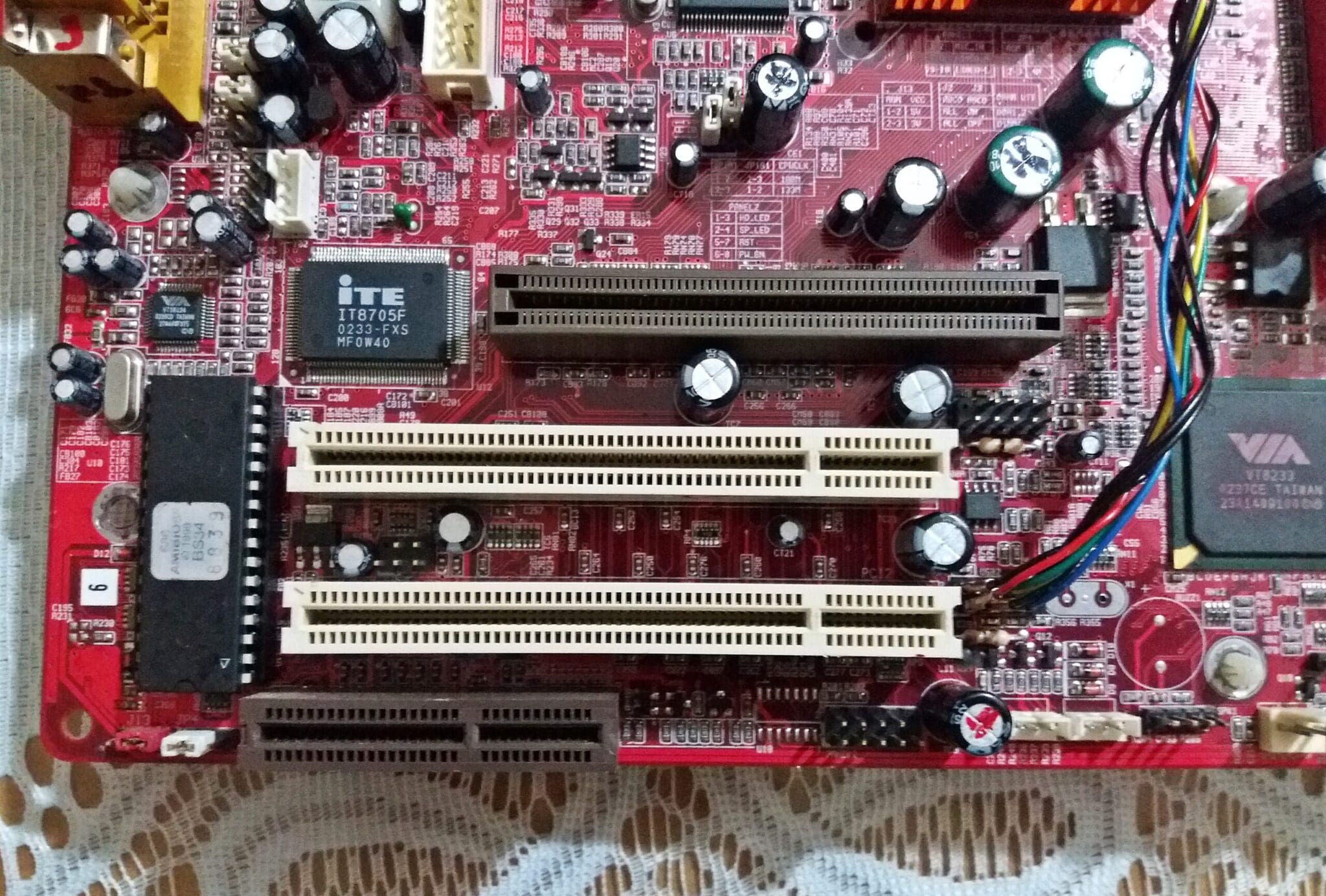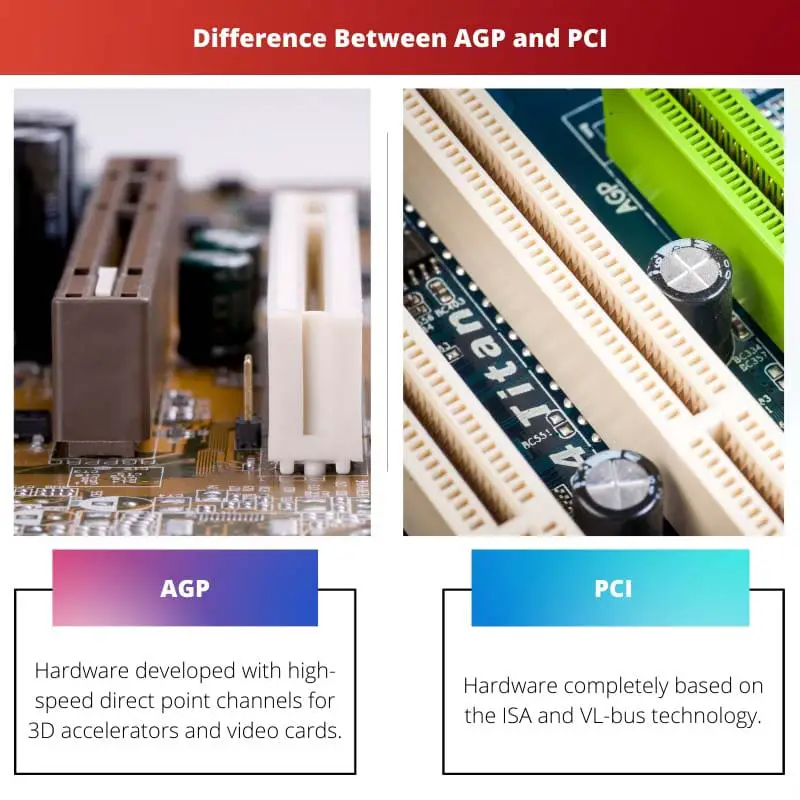A Graphics card in a computer or laptop is hardware that enhances the quality of the video memory, and the display of the screen is also changed to high-definition.
The capacity and the power of any computer or laptop are upgraded with the type of graphic card used in it. It also allows it to perform high-level tasks on the computer.
There are two different types of graphic cards that are the – integrated graphic card and the discrete graphic card.
Key Takeaways
- AGP is a high-speed interface designed specifically for graphics cards, while PCI is a general-purpose expansion slot for various devices.
- AGP provides a dedicated connection between the graphics card and the CPU, offering faster performance than PCI for graphics processing.
- PCI is more versatile and can accommodate multiple devices, whereas AGP is limited to one graphics card per system.
AGP vs PCI
AGP (Accelerated Graphics Port) is a now-obsolete standard designed specifically for connecting graphics cards to the motherboard. PCI (Peripheral Component Interconnect) is a more general-purpose bus standard used for connecting a wide range of peripheral devices to a computer’s motherboard.

AGP is the abbreviation used for the Accelerated Graphic Port. As the name says, AGP is placed in the computer or a laptop as a port and is small in size and can be identified by its identical color which is brown.
The hardware feature was introduced in the year 1996 and has a bandwidth of around 533 Mb/s.
PCI is the abbreviation used for the Peripheral Component Interface. This hardware comes in the form of a bus and is present in a comparatively larger size than of AGP port and is in white.
The technology is completely based on the VL-bus and ISA technology. And it was introduced in the year 1992 and standardized by PCI Special Interest Group.
Comparison Table
| Parameters of Comparison | AGP | PCI |
|---|---|---|
| Definition | Hardware developed with high-speed direct point channels for 3D accelerators and video cards. | Hardware completely based on the ISA and VL-bus technology. |
| Abbreviation | Accelerated Graphic Port | Peripheral Component Interconnect |
| Introduced In | 1996 | 1992 |
| Purpose | Used alongside the graphic card | I/O interface bus |
| Priority Queues | Maybe high/low | Absent |
| 3D Graphics quality | High | Low |
| Requests | Pipelined | Non-pipelined |
| Peripheral Device | High | Low |
| Address/Data | De-Multiplexed | Multiplexed |
| Slots | Short | Long |
| Target | Single | Multiple |
| Peak at 32 bits | 533 Mb/s | 133 Mb/s |
What is AGP?
AGP is the abbreviation for the term Accelerated Graphic Port and was introduced in 1996 by the company Intel.
It can be defined as the hardware that can directly point channels and has the high speed for 3D accelerators and video cards. The sole purpose of the hardware was to work alongside the graphic card.
The unique feature possessed by the AGP hardware is the DIME (Direct Memory Access) which means the hardware can directly access the computer’s main memory and perform the complex texture mapping process.
The bandwidth of the hardware is quite high and is approximately 533 Mb/s.
The size of the slot is comparatively shorter and only one in number also, the color of the AGP slot is brown. The transaction length for the AGP is 8 bytes, while for boundaries, it is also 8 bytes. And the priority queues are absent in the technology.

What is PCI?
PCI is the abbreviation used for the Peripheral Component Interconnect, and the technology was introduced back in the year 1992 and got its standardization by PCI Special Interest Group.
The complete technology used for building the technology was ISA and VL-bus technology. The sole purpose of the technology was to generalize the Input/Output interface bus.
The bandwidth of the PCI technology is comparatively shorter and approximately 133 Mb/s. Also, it lacks the feature DIME and generates a single request for data transfer, while the next request is not generated until the first is completed.
The size of the slot of the PCI is comparatively larger and is multiple. The color of these slots is white. The transaction length for the PCI is 4 bytes, while for boundaries, it is 4 bytes.

Main Differences Between AGP and PCI
- AGP can be stated as the hardware having channels and high speed for the 3D accelerator and video cards, while comparatively, on the other hand, the PCI can be stated as the technology that is built on keeping ISA and VL-bus in mind.
- AGP is the abbreviation used for the term Accelerated Graphic Port whereas comparatively, on the other hand, PCI is the abbreviation used for the term Peripheral Component Interconnect.
- The hardware system AGP was introduced in 1996, while comparatively on the other hand, the technology system PCI was introduced in 1992.
- The main aim of the AGP is to work alongside graphic cards, while comparatively, on the other hand, the main aim of PCI is the Input/Output interface bus.
- The priority queue for the AGP may be high or low, while comparatively, on the other hand, the priority queue for the PCI is absent.
- The quality of the 3D graphics for the AGP is quite high, while comparatively, on the other hand, the quality of the 3D graphics for PCI is low.
- The AGP generates a single pipeline request, while comparatively, on the other hand, the PCI generates multiple non-pipeline requests.
- The peripheral device configuration through AGP is more, while comparatively, on the other hand, the peripheral device configuration through PCI is less.
- The data of AGP is considered to be de-multiplexed, while comparatively, on the other hand, the data of PCI is considered to be multiplexed only.
- The size of the slots is short in the case of AGP and is brown, while comparatively, on the other hand, the size of the slots is large in the case of PCI and is white.
- The AGP has a specific single target, while comparatively, on the other hand, the PCI has multiple specific targets.
- The bandwidth of AGP is around 533 Mb/s, while on the other hand, the bandwidth of the PCI is approximately around 133 Mb/s.

- https://www.mindshare.com/files/resources/MindShare_Intro_to_PCIe.pdf
- https://www.elibrary.ru/ip_restricted.asp?rpage=https%3A%2F%2Fwww%2Eelibrary%2Eru%2Fitem%2Easp%3Fid%3D3173970
- https://ieeexplore.ieee.org/abstract/document/915139
- https://www.elibrary.ru/ip_restricted.asp?rpage=https%3A%2F%2Fwww%2Eelibrary%2Eru%2Fitem%2Easp%3Fid%3D8443826

The references cited in the article demonstrate the depth of research and authoritative sources used to support the content.
The tone of the article seems overly technical and academic, which may limit its accessibility to a broader audience.
The level of detail in the article is commendable, but it may require further simplification to cater to non-technical readers.
I agree, the content could benefit from a more user-friendly approach to engage a wider readership.
The article presents an important topic, especially in the field of computing technology.
You’re absolutely right. The article provides key information in a comprehensive and succinct manner.
The comparison table provides a clear overview of the differences between AGP and PCI, making it easier to understand their unique characteristics.
While the article covers the technical aspects of AGP and PCI extensively, it lacks a discussion on the practical implications for users and system performance.
The article fails to address the potential impact of emerging technologies on the relevance of AGP and PCI in modern computing systems.